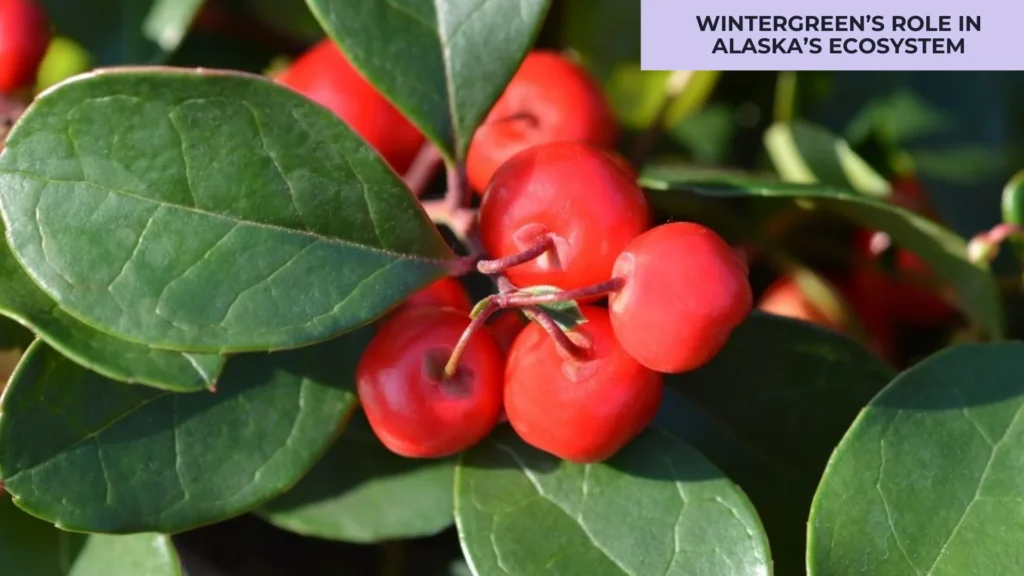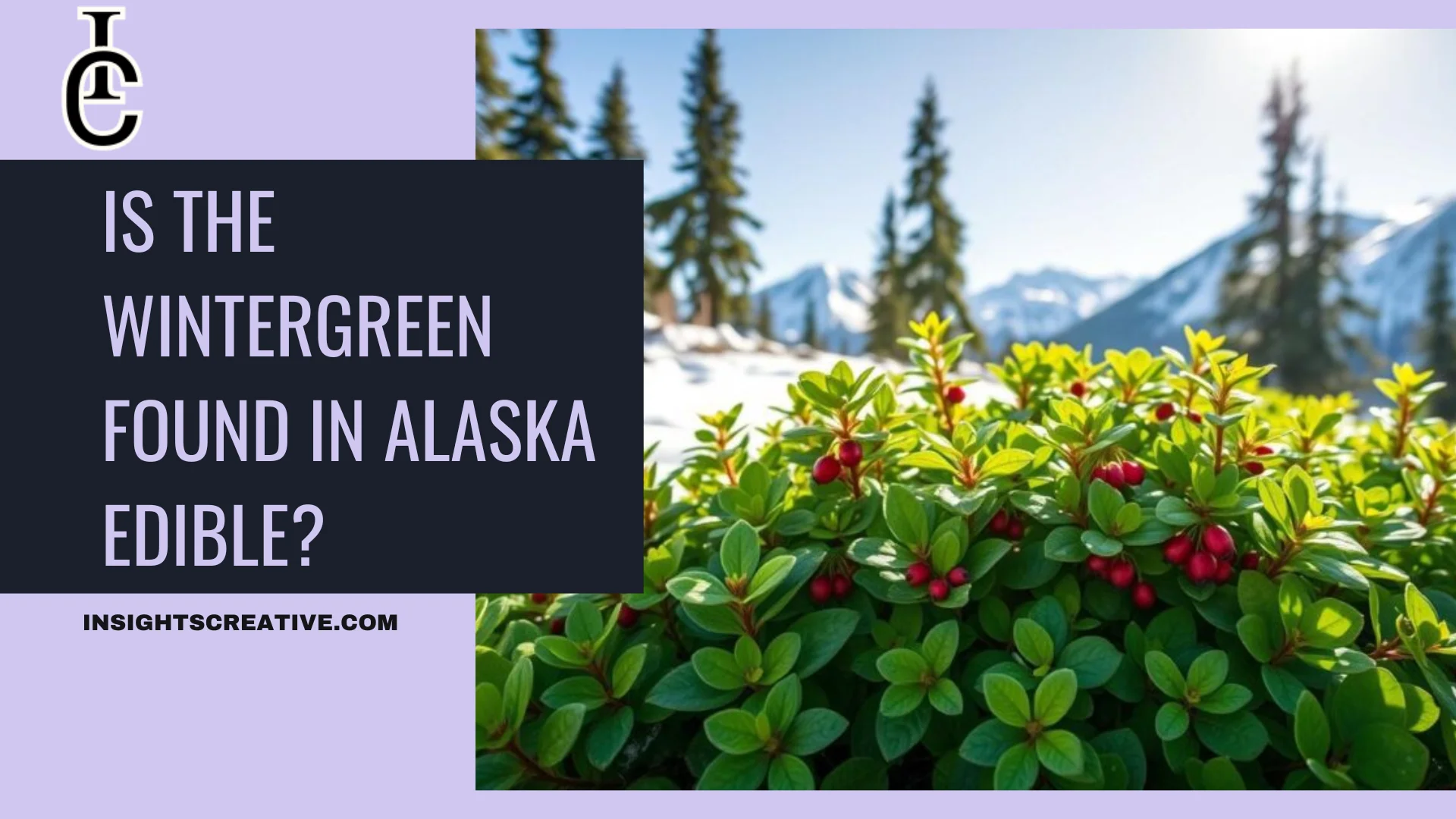Wintergreen is a fascinating plant with a rich history and a variety of uses, especially in the wild landscapes of Alaska. For those interested in foraging or understanding the ecological value of native plants, a key question often arises: “Is the wintergreen found in Alaska edible?” The answer is yes, but there’s much more to explore about its characteristics, benefits, and role within the ecosystem. This article delves into the specifics of wintergreen, its uses, and how it fits into Alaska’s unique environment.
Introduction
The landscapes of Alaska are home to a range of edible wild plants, each offering unique flavors and nutritional benefits. Wintergreen, or Gaultheria procumbens, is one such plant. It is commonly associated with its fresh, minty aroma, a distinctive feature that makes it stand out among other wild herbs. However, can wintergreen be found in Alaska, and is it safe to consume? The short answer is yes, both the berries and leaves of the wintergreen plant are edible when used correctly. Understanding the properties and uses of wintergreen helps enrich the knowledge of foragers and nature enthusiasts, ensuring safe and sustainable practices.
Understanding Wintergreen: Botany and Identification
Key Characteristics of Wintergreen
Wintergreen is a low-growing, evergreen shrub that thrives in cool, shaded areas, making it well-suited to Alaska’s climate. Its dark green leaves are leathery and emit a strong, minty scent when crushed. This characteristic has made wintergreen flavor a common choice in chewing gum and candy. The plant produces bright red berries that remain through the winter, providing a splash of color in snow-covered landscapes. These berries are small, round, and often a key focus for those exploring edible plants in the region.
Differentiating Species of Wintergreen in Alaska
While Gaultheria procumbens is the most well-known species, there are other plants in Alaska that share similar characteristics. Being able to distinguish between these species is essential for safe foraging. For example, some may confuse wintergreen with plants like Gaultheria hispidula, which also grows in similar environments. However, knowing the leaf shape, berry size, and growth pattern can help differentiate between edible wintergreen and potentially harmful look-alikes. This skill is particularly valuable for those looking to incorporate wild herbs found in Alaska for cooking into their meals.
Is the Wintergreen Found in Alaska Edible?
Edibility of Wintergreen Berries
The wintergreen berries are not only edible but have a unique, mildly sweet taste that carries a hint of mint. They can be eaten raw or used in a variety of culinary applications, such as infusing syrups or making jams. The berries contain small amounts of vitamin C and are often a treat for those who come across them while hiking. However, it’s essential to eat them in moderation due to their strong flavor. Unlike other wild berries found in Alaska, wintergreen berries are less commonly found in large quantities, making them a rare but delightful find.
Edibility of Wintergreen Leaves
Beyond the berries, the wintergreen leaves are also safe to consume when used correctly. Often, the leaves are brewed into a tea that carries a soothing, mint-like flavor, which is traditionally used to relieve minor aches and pains. The leaves’ aromatic nature makes them a good addition to herbal blends, providing a refreshing taste. For those familiar with wild plants that can be used as seasoning in Alaska, wintergreen leaves can also add a unique twist to various dishes. The leaves should be dried before use in teas to ensure the best flavor extraction.
Nutritional and Medicinal Benefits of Wintergreen
Nutritional Value of Wintergreen
Wintergreen may not be a staple food source, but it offers some nutritional benefits that make it valuable for those seeking wild edibles. The berries, though small, contain vitamins like vitamin C and antioxidants, supporting immune health. While the leaves are primarily used for their flavor, they also contain methyl salicylate, a compound that offers medicinal properties similar to aspirin. Incorporating wintergreen into one’s diet can complement the benefits of other edible wild greens found in Alaska, providing a diverse range of nutrients.
Medicinal Properties of Wintergreen
Wintergreen has long been valued for its medicinal properties, especially among indigenous communities in Alaska. Methyl salicylate, found in wintergreen oil, has anti-inflammatory and pain-relieving effects. This makes it effective for topical use in alleviating muscle pain and sore joints. Historically, wintergreen tea was used as a remedy for headaches and mild cold symptoms. It is similar in effect to willow bark, another natural source of salicylates. Today, wintergreen essential oil uses extend to aromatherapy and muscle rubs, making it a popular choice for those seeking natural health solutions.
Safety and Precautions When Using Wintergreen
While wintergreen essential oil benefits are numerous, it is important to use this plant with caution. The concentrated oil, in particular, can be toxic if ingested in large quantities. When using wintergreen for culinary or medicinal purposes, it’s best to stick to traditional methods like teas and avoid extracting the oil yourself. Consulting a qualified herbalist or forager can ensure safe use, especially for those new to wild foraging. By following these precautions, one can enjoy the benefits of wintergreen without risk.
Wintergreen’s Role in Alaska’s Ecosystem
Wildlife Food Source: Wintergreen’s Contribution
Wintergreen is more than just a human delicacy; it also plays a crucial role in the diets of local wildlife. The bright red berries, available during the harsh winter months, serve as a vital food source for birds and small mammals. This makes wintergreen an important part of the forest food web, providing sustenance when other food sources are scarce. The presence of wintergreen supports biodiversity, making it a key species among plants found in wooded areas in Alaska.

Wintergreen’s Impact on Soil and Forest Health
Wintergreen contributes to soil and forest health by helping to stabilize soil and maintain moisture levels in the forest floor. Its presence as a ground cover plant helps prevent soil erosion, especially in areas with heavy rainfall. This stabilizing effect is crucial for maintaining the health of other plant species and ensuring the overall vitality of forest ecosystems. By protecting the soil and contributing to the health of surrounding plants, wintergreen plays a part in the overall resilience of Alaska’s forests.
Traditional and Modern Uses of Wintergreen in Alaska
Indigenous Uses of Wintergreen
Indigenous communities in Alaska have used wintergreen for generations, both as a food source and for its medicinal properties. The knowledge of which wild plants are safe to consume has been passed down, ensuring sustainable use. Wintergreen tea was traditionally used to soothe sore throats and relieve pain, while the berries were a treat during the long winter months. This cultural heritage highlights the value of wintergreen beyond its flavor and medicinal properties.
Modern Culinary Uses of Wintergreen
Today, wintergreen continues to find its way into modern kitchens. Chefs and home cooks use it as a unique flavoring in teas, syrups, and even desserts. Its minty aroma pairs well with chocolate, berries, and other sweet ingredients. Wintergreen has also been used to infuse oils, offering a fragrant addition to salad dressings or marinades. Those exploring wild herbs for cooking in Alaska find wintergreen to be a versatile ingredient that can elevate a variety of dishes.
Commercial Applications of Wintergreen
Wintergreen’s commercial applications are diverse, ranging from wintergreen essential oil in pain relief products to flavoring in candies and toothpaste. The oil is especially popular in topical ointments designed to soothe sore muscles, drawing on its natural analgesic properties. The distinct wintergreen flavor remains a popular choice in chewing gum and lozenges, offering a refreshing taste that has been cherished for generations.
Environmental Considerations
Sustainable Harvesting of Wintergreen
Sustainable harvesting practices are crucial for preserving wintergreen populations. When gathering wild plants in Alaska, it’s important to take only what is needed, leaving plenty behind to ensure the plant’s ability to reproduce. Foraging in this manner helps maintain healthy populations of wintergreen, ensuring that it continues to play its role in the ecosystem. Respectful harvesting aligns with the practices of indigenous foragers who have long understood the importance of balance in nature.
Protecting Wintergreen’s Habitat
Wintergreen thrives in the understory of forests, where it benefits from the dappled sunlight and rich, moist soil. Protecting these forested areas from overdevelopment or deforestation is key to ensuring the continued growth of wintergreen. Conservation efforts that focus on maintaining Alaska’s natural landscapes directly benefit wild herbs and plants like wintergreen, preserving them for future generations to enjoy.
Adapting Wintergreen Harvesting to Climate Change
As climate change continues to alter environmental conditions, the growth patterns of wintergreen may change. Warmer temperatures and shifts in precipitation can impact the plant’s growth cycles, making it more challenging to predict where it will thrive. Adaptive management practices, such as adjusting harvesting times and monitoring plant populations, can help foragers and conservationists ensure that wintergreen remains a part of Alaska’s natural landscape.
Conclusion: The Importance of Wintergreen in Alaska
Wintergreen is more than just an edible plant; it is a symbol of resilience and adaptation in Alaska’s harsh environment. Understanding is the wintergreen found in Alaska edible opens upWintergreen is more than just an edible plant; it is a symbol of resilience and adaptation in Alaska’s harsh environment. Understanding “is the wintergreen found in Alaska edible” opens up opportunities to explore its use in local cuisine, traditional medicine, and ecological contributions. With a proper understanding of safe consumption, foraging practices, and sustainable harvesting, wintergreen offers a taste of Alaska’s natural heritage. Its role in supporting wildlife and maintaining soil health further underscores its importance in the ecosystem.







